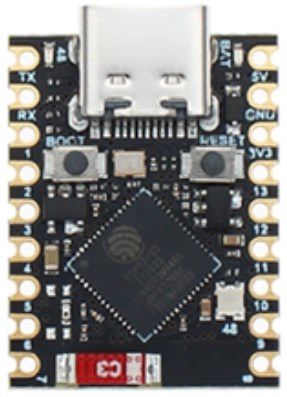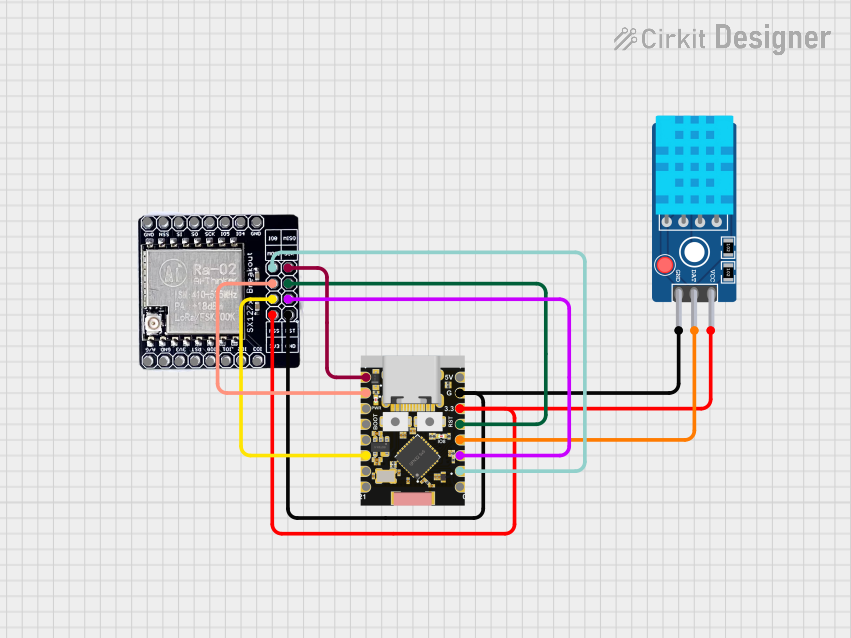
How to Use ESP32 S3 Super Mini: Examples, Pinouts, and Specs

 Design with ESP32 S3 Super Mini in Cirkit Designer
Design with ESP32 S3 Super Mini in Cirkit DesignerIntroduction
The ESP32 S3 Super Mini is a compact and powerful microcontroller developed by ESP32. It is designed for Internet of Things (IoT) applications, offering integrated Wi-Fi and Bluetooth connectivity. With its dual-core processing capabilities, the ESP32 S3 Super Mini is ideal for projects requiring high performance, low power consumption, and versatile connectivity options. Its small form factor makes it suitable for space-constrained designs.
Explore Projects Built with ESP32 S3 Super Mini

 Open Project in Cirkit Designer
Open Project in Cirkit Designer
 Open Project in Cirkit Designer
Open Project in Cirkit Designer
 Open Project in Cirkit Designer
Open Project in Cirkit Designer
 Open Project in Cirkit Designer
Open Project in Cirkit DesignerExplore Projects Built with ESP32 S3 Super Mini

 Open Project in Cirkit Designer
Open Project in Cirkit Designer
 Open Project in Cirkit Designer
Open Project in Cirkit Designer
 Open Project in Cirkit Designer
Open Project in Cirkit Designer
 Open Project in Cirkit Designer
Open Project in Cirkit DesignerCommon Applications and Use Cases
- Smart home devices (e.g., smart lights, thermostats)
- Wearable technology
- Industrial IoT systems
- Wireless sensor networks
- Robotics and automation
- Prototyping and development of connected devices
Technical Specifications
The following table outlines the key technical specifications of the ESP32 S3 Super Mini:
| Specification | Details |
|---|---|
| Manufacturer | ESP32 |
| Part ID | S3 Super Mini |
| Processor | Dual-core Xtensa® LX7 |
| Clock Speed | Up to 240 MHz |
| Flash Memory | 4 MB (varies by model) |
| RAM | 512 KB SRAM |
| Wireless Connectivity | Wi-Fi 802.11 b/g/n (2.4 GHz), Bluetooth 5.0 LE |
| GPIO Pins | 27 GPIOs (configurable for digital, analog, I2C, SPI, UART, PWM, etc.) |
| Operating Voltage | 3.3V |
| Input Voltage Range | 3.0V to 3.6V |
| Power Consumption | Ultra-low power consumption in deep sleep mode |
| Dimensions | 20 mm x 15 mm |
| Operating Temperature | -40°C to +85°C |
Pin Configuration and Descriptions
The ESP32 S3 Super Mini features a variety of pins for versatile connectivity. Below is the pinout description:
| Pin Name | Type | Description |
|---|---|---|
| GND | Power | Ground |
| 3V3 | Power | 3.3V power output |
| EN | Input | Enable pin (active high) |
| GPIO0 | I/O | General-purpose I/O, boot mode selection |
| GPIO1-27 | I/O | Configurable for digital, analog, I2C, SPI, UART, PWM, etc. |
| TXD0 | Output | UART0 transmit |
| RXD0 | Input | UART0 receive |
| ADC1_CH0-9 | Input | Analog-to-digital converter channels |
| DAC1, DAC2 | Output | Digital-to-analog converter outputs |
| SPI_CLK | I/O | SPI clock |
| SPI_MOSI | Output | SPI master-out, slave-in |
| SPI_MISO | Input | SPI master-in, slave-out |
| I2C_SCL | I/O | I2C clock line |
| I2C_SDA | I/O | I2C data line |
Usage Instructions
How to Use the ESP32 S3 Super Mini in a Circuit
- Powering the Module: Provide a stable 3.3V power supply to the
3V3pin and connectGNDto ground. - Programming: Use a USB-to-serial adapter to connect the module to your computer. Connect:
TXD0to the adapter's RX pinRXD0to the adapter's TX pinGNDto the adapter's ground
- Boot Mode: To enter bootloader mode for programming, hold the
GPIO0pin low while resetting the module. - GPIO Configuration: Configure the GPIO pins as needed for your application (e.g., digital I/O, PWM, ADC, etc.).
- Wireless Connectivity: Use the built-in Wi-Fi and Bluetooth capabilities to connect to networks or other devices.
Important Considerations and Best Practices
- Voltage Levels: Ensure all connected peripherals operate at 3.3V logic levels to avoid damaging the module.
- Antenna Placement: For optimal wireless performance, avoid placing metal objects or other components near the onboard antenna.
- Power Supply: Use a low-noise, stable power supply to prevent issues with Wi-Fi and Bluetooth operation.
- Deep Sleep Mode: Utilize the deep sleep mode to minimize power consumption in battery-powered applications.
Example: Connecting to an Arduino UNO
The ESP32 S3 Super Mini can be used with an Arduino UNO for extended functionality. Below is an example of connecting the ESP32 S3 Super Mini to Wi-Fi using the Arduino IDE:
#include <WiFi.h> // Include the Wi-Fi library for ESP32
// Replace with your network credentials
const char* ssid = "Your_SSID";
const char* password = "Your_PASSWORD";
void setup() {
Serial.begin(115200); // Initialize serial communication
delay(1000);
Serial.println("Connecting to Wi-Fi...");
WiFi.begin(ssid, password); // Start Wi-Fi connection
// Wait for connection
while (WiFi.status() != WL_CONNECTED) {
delay(500);
Serial.print(".");
}
Serial.println("\nConnected to Wi-Fi!");
Serial.print("IP Address: ");
Serial.println(WiFi.localIP()); // Print the device's IP address
}
void loop() {
// Add your main code here
}
Troubleshooting and FAQs
Common Issues and Solutions
Module Not Responding
- Cause: Incorrect wiring or power supply issues.
- Solution: Double-check all connections and ensure a stable 3.3V power supply.
Wi-Fi Connection Fails
- Cause: Incorrect SSID or password, or weak signal strength.
- Solution: Verify the network credentials and ensure the module is within range of the Wi-Fi router.
Bootloader Mode Not Entering
- Cause: Improper boot mode selection.
- Solution: Ensure the
GPIO0pin is held low while resetting the module.
Overheating
- Cause: Excessive current draw or poor ventilation.
- Solution: Check the circuit for short circuits and ensure proper heat dissipation.
FAQs
Q: Can the ESP32 S3 Super Mini operate at 5V?
A: No, the module operates at 3.3V. Connecting 5V directly may damage the module.Q: How do I update the firmware?
A: Use the ESP32 Flash Download Tool or the Arduino IDE to upload new firmware via the UART interface.Q: Can I use the ESP32 S3 Super Mini for Bluetooth audio?
A: Yes, the module supports Bluetooth 5.0 LE, which can be used for audio streaming with appropriate libraries.Q: What is the maximum range of the Wi-Fi?
A: The range depends on environmental factors but typically extends up to 100 meters in open space.
This documentation provides a comprehensive guide to using the ESP32 S3 Super Mini effectively in your projects.